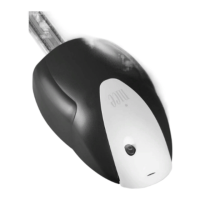ENGLISH – 27
FURTHER INFORMATION
(Accessories)
9
9 FURTHER DETAILS (Accessories)
9.1 ADDING OR REMOVING DEVICES
Function found in the INSTALLATION menu.
Devices can be added or removed at any time on a completed au-
tomation. In particular, various types of devices can be connected
to the “STOP” input, as explained in the following paragraphs.
For each change made to the automation’s components, it is nec-
essary to run the procedure described here to guarantee its correct
operation.
To start this procedure:
1. access the INSTALLATION menu (see the “Programming
the control unit” chapter on page 16)
2. press and hold the
g
button (roughly 6 seconds)
(“Figure 52“)
DISPLAY
STOP/SET
52
3. at the end of the device acquisition process, the display will
ash slowly: release the
g
button
l
If the symbol on the display fails to ash slowly
again, wait 15 seconds without pressing any button.
The control unit will automatically cancel the instal-
lation procedure. Rerun the procedure from point 1.
4. press the
h
button to reach the exit symbol and
then press the
g
button once to exit the menu.
9.1.1 STOP input
STOP is the input that causes the immediate interruption of the
manoeuvre, followed by a brief inversion. Devices with normally
open (“NO”) and normally closed (“NC”) contacts, optical devices
(“Opto Sensors”) or devices with 8.2 kΩ xed resistor output (such
as sensitive edges) can be connected to this input.
During the device learning phase, the control unit recognises the
type of device connected to the STOP input and later, during nor-
mal use of the automation, the control unit commands a STOP
when it senses a change with respect to the acquired situation.
Multiple devices, even of different types, can be connected to the
STOP input if suitable arrangements are made:
– Any number of NO devices can be connected to each other in
parallel.
– Any number of NC devices can be connected to each other in
series.
– Two devices with 8.2 kΩ xed resistor output can be connected
in parallel; if there are more than 2 devices then they must all be
connected in cascade, with a single 8.2 kΩ terminating resistor.
– It is possible to combine two NO and NC contacts by placing
them in parallel, while also mounting a 8.2 kΩ resistor in series
with the NC contact (this also allows for combining 3 devices:
NA, NC and 8.2 kΩ).
– To connect an optical device, refer to the diagram shown in “Fig-
ure 53”. The maximum current supplied on the 12 VDC line is
15 mA.
1
2
345
6
78
OPTICAL SENSOR
(max 15mA)
12 Vdc (+)
SIGNAL
GND (-)
53
9.1.2 Photocells with PHOTOTEST function
The control unit features a PHOTOTEST function which increases
the reliability of the safety devices, enabling it to be classied in
Category 2 in accordance with the EN 13849-1 standard regarding
the combination of the control unit and safety photocells.
Whenever a manoeuvre is started, all safety devices involved are
checked and only if everything operates correctly will the manoeu-
vre start.
Should the test fail (photocell blinded by the sun, cables short-cir-
cuited, etc.), the fault is identied and the manoeuvre is disabled.
Connect the photocells as shown in “Figure 54”.
a
The maximum usable current on the PHOTOTEST
output is 15 mA.
m
If 2 pairs of photocells are used that interfere with
one another, it is necessary to activate the “syn-
chronisation” as described in the photocell instruc-
tion manual.
m
In any devices of the automation are replaced, add-
ed or removed, it is necessary to run the learning
procedure (see the “Programming the door opening
and closing positions” chapter on page 12).

